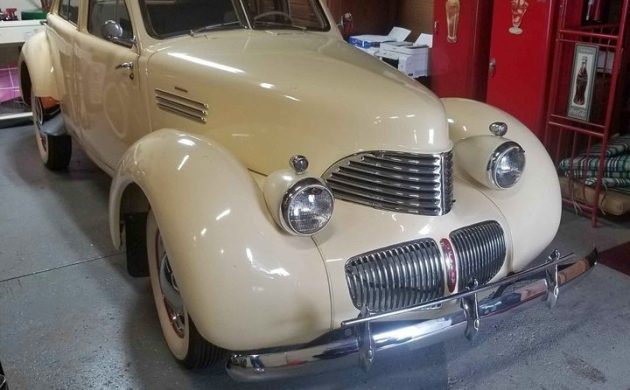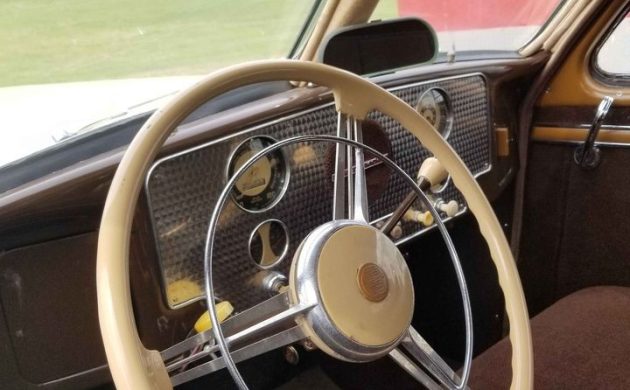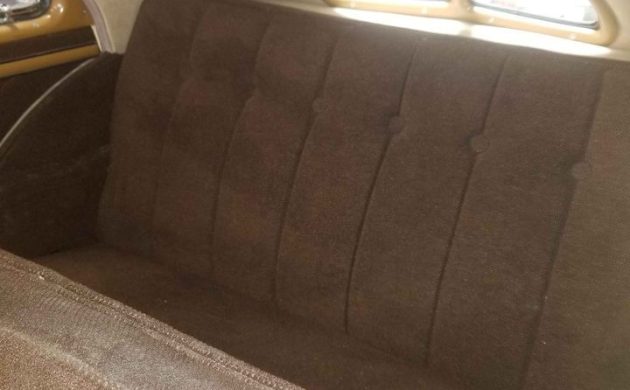By the late 1930s, The Hupp Motor Car Company was fighting for its life after more than a decade of declining market share. In what can, in retrospect, be seen as an act of desperation, the company purchased the body dies to produce the Cord 810 body with the intent of using this as a foundation for their next car. Financial weakness forced them to partner with Graham-Paige to produce these complicated bodies for both companies. This 1940 Graham Hollywood for sale on Facebook Marketplace in Fort Wayne, Indiana is one of the roughly 1,500 automobiles built in what turned out to be the last gasp of this fabled nameplate. Fresh from long-term storage, this distinctive vehicle presents well and is ready for a new owner with an asking price of $27,900. Is this distinctive sedan the type of orphan car that would interest you? Thanks to T.J. for this fantastic find!
In the latter part of the 1930s, independent automakers were beginning to feel the financial squeeze not just from the Depression, but from the economies of scale enjoyed by Ford, GM, and Chrysler. These once well-respected automakers were also having to deal with the increased complexity of automobiles as time marched on and even the frequent model changes by “The Big Three” were taxing their already meager resources and abilities to compete. For the Hupp Motor Car Company, the end was frighteningly near. The company made a “Hail Mary” purchase of the old Cord dies in 1938. This was seen as a chance for the company to regain its position in the market with a stunningly beautiful car.
The one thing that the company seemed to ignore is that these dies and the Cord 810 and 812 they were built from didn’t help that company escape from financial troubles. The biggest problem was that these bodies were produced by dies making seven separate panels that had to be joined together to make the whole body. Stamping technology was evolving quickly, and companies like Ford, GM, and Chrysler could afford to purchase the enormous machines needed to produce large stampings that would have replaced this type of production and thus enjoy huge savings on labor costs. Hupp and Graham, who it had partnered with to produce the bodies, were forced to compete with cars that could be produced for less money and less time in the same market space.
Despite the challenges, the companies pushed on. Graham used their facilities to build the car, and both companies agreed to use the same John Tjaarda-designed sheet metal from the cowl forward. Each company would install its own drivetrain. Prototypes displayed at auto-shows generated a healthy number of preorders. Yet it was the issues encountered in producing these complicated bodies that caused many of those orders to be canceled after numerous delays soured customer feelings. Even the utilization of famed coachbuilders Hayes Manufacturing Corporation, itself just reemerging from reorganization, to build the bodies drained off resources both companies didn’t have. Production figures vary by quite a bit, but it is believed that at least 319 Hupp Skylarks and 1,500 Graham Hollywoods made it out the doors of the soon-to-be-shuttered factories.
The car you see here is a very nice example of the Graham version of this doomed partnership. We are told that it is a nice driver that runs great. The interior is advertised as new despite the dinginess seen in the picture above. Perhaps that is from being in long-term storage for an undisclosed amount of time. The body is said to need some cosmetics, but the irreplaceable chrome trim on the car is described as nice. The new owner is also warned that the braking system will need to be gone through.
The picture above hints that this is a nice original car that has received a repaint in the past. The shade of light cream on the cowl is noticeably lighter than the paint covering the body. The engine also looks to have its original, somewhat degraded finish. It is also noticeable that this is one of the Hollywoods that did not come with an optional supercharger. The supercharged engine put out 124 horsepower instead of the normally aspirated engine’s 116 horsepower. Despite the slight lack of horsepower, Hollywoods and Skylarks were known to be fast cars due to their relatively light curb weight, and the handling afforded by their lower center of gravity earned them many fans over the years.
One of those fans was my grandfather, who owned several Hupp Skylarks. While most were purchased for parts, he did partially restore a very nice survivor car. This Skylark was a favorite of my grandmother. She was known to have a heavy right foot and was frequently seen speeding through town and around corners. He tried to keep the car at his shop and out of her “reckless” hands. Sadly, the car met its demise when he let one of his drunken pals use it to run an errand. The car was rear-ended by another drunk with such severity that it was unrepairable. She was heartbroken that her favorite car was destroyed. He gave up on Skylarks and moved on to the two antique cars that I currently own. She never let him forget that it was his drunken pal that destroyed the Skylark and not, as he predicted, her. All that is left of this history of Skylarks in the family is a single taillight lens that I still have and look at occasionally wondering what if…
Have you ever seen or owned a Hupmobile Skylark or Graham Hollywood? Would you be interested in an example like this one? Please share your thoughts and stories in the comments.








Nice write-up, Jeff. In my life I have seen just one of these in the flesh and the only thing I knew about them was that they used Cord body dies – it’s nice to learn a little more about them. Was that engine supplied by Continental Motors by any chance?
Yes and no? The motors were Graham designed 6cyl. flatheads, but were made by Continental as Graham did not have its own foundry. When Graham went out of the car business they sold the rights to Continental and they marketed it under their name to other car makers. Kaiser-Frazer and Checker used them and they were also used for industrial applications.
Which Continental engines?
I have a Case and an ATC Terratrac crawler loaders with Continental engines.
Both have their own uniqueness.
Case has a dry clutch and a torque convertor.
The Terratrac was the first to have torque convertor drive. It does so using 3 of them.
Interesting thar the supercharger was good for so little horsepower. Hoping the torque increase was more impressive
In fact, Graham’s own advertised figures show the 116 hp rating was for the 1939 supercharged engine. The naturally aspirated base engine was rated at 90 hp that year.
For 1940 models including the Hollywood (no Hollywood for ’39), the numbers were 120 hp supercharged and 93 hp naturally aspirated. 1941 saw horsepower increase to 124 supercharged and 95 naturally aspirated. So there was a considerable horsepower increase with the supercharger.
Sounds like you’re on your way, Jeff-just need to find a Hupp Skylark needing a home and a taillight lense to put it on.. Your grandfather had good taste.
Jeff, I think you meant to say that the roof panel was made up of seven separate stampings. I recall reading something to that effect in Collectible Automobile magazine years ago. Besides, building an entire body out of seven stampings would be a revelation!
So Deco. I like these and I don’t care for many prewar cars. Yesterday I was at a car show and saw a late forties, I guessed, Pontiac straight eight. Flathead engine and style somewhat like this one. Gangster looking.
These are definitely some of the best looking cars of this Era. Too bad there were so few built.
This was one of the vehicles featured in the Tad Burness book called Auto Album. That book really helped kickstart my life-long addiction. I still have it in a box somewhere.
After Graham stopped production in 1941 , the factory stamping equipment was sold to Joseph Frazer who was going to revive the Graham name and build a new model car in 1946. He was introduced to Henry J.Kaiser and the two began building Kaisers and Frazers. Frazer had auto experience from being with both Chrysler and Willys but Henry had the majority of stock so what Henry said was law. Frazer was gone by 1951
Excellent write up/ article Jeff. Well researched…very interesting & little known chapter in US automotive history
I had a 1936 Cord Westchester, COMPLETELY restored by George Ehresman in West Springfield, MA. Color was Palm Beach Tan. I ran it little because of fear of stone chips. Never-the-less, it was a lifelong dream to own a Cord. This was in 1996. Eventuality sold to a buyer in Toronto. Loved the design by Gordon Breuig and thought Graham did not do it justice. Breuig designed the first all metal Ford station wagon.
Beauty. I’d rebuild that engine and the super charger.
It is nice to see one of these in original state. I saw more of them around 1940, than their production numbers would suggest: they seemed like a fairly popular car at the time. Maybe there simply was an especially effective dealership near me. However, in more recent years, I have seen so many of these made into hot rods and street rods, that I wonder how many originals even exist? I didn’t care much for the look, myself; but then, I was not so fond of Cord styling, either. My attention went to the 1938 V-8 Ford Deluxe four door, and to the 1939 Buick (tells you something about how I looked at cars 85 years ago) (wow! — time goes FAST!!!) I look at my own age, and it is hard to believe that such a number belongs to me! I mean, people my age used to be OLD… VERY old… EXCEPTIONALLY old! I remember when my great-grandparents were in their nineties, and how ancient they seemed to me. Please SMILE when you use that word, “ancient” around me — I might wax “sensitive” about that! (not really, but it SOUNDed good; didn’t it?). One thing I notice: pretty young girls call me “Honey” and are so sweet to me now (‘twould have been nice, had they treated me that way 70 years ago! — but then, I guess, I now look twinkle-eyed, white-haired, withered-up, and harmless).
Why do I see this:
“Your comment is awaiting moderation.”
frequently?
We get a lot of comments everyday so we have some filters in place that catch things until we can look at them. It might happen when you post a photo or link or if there’s a word in there. It’s nothing against you and we try to review them as quickly as we can.
I simply love these cars!!! I have two of them in storage and they both need restoring and are apart. bought them years ago and the best thing is they are out of the weather and not rusting away. i have seen them street rodded at shows, and I can tell you that a few of them are so beautiful it’s unbelievable how perfect they made them look.